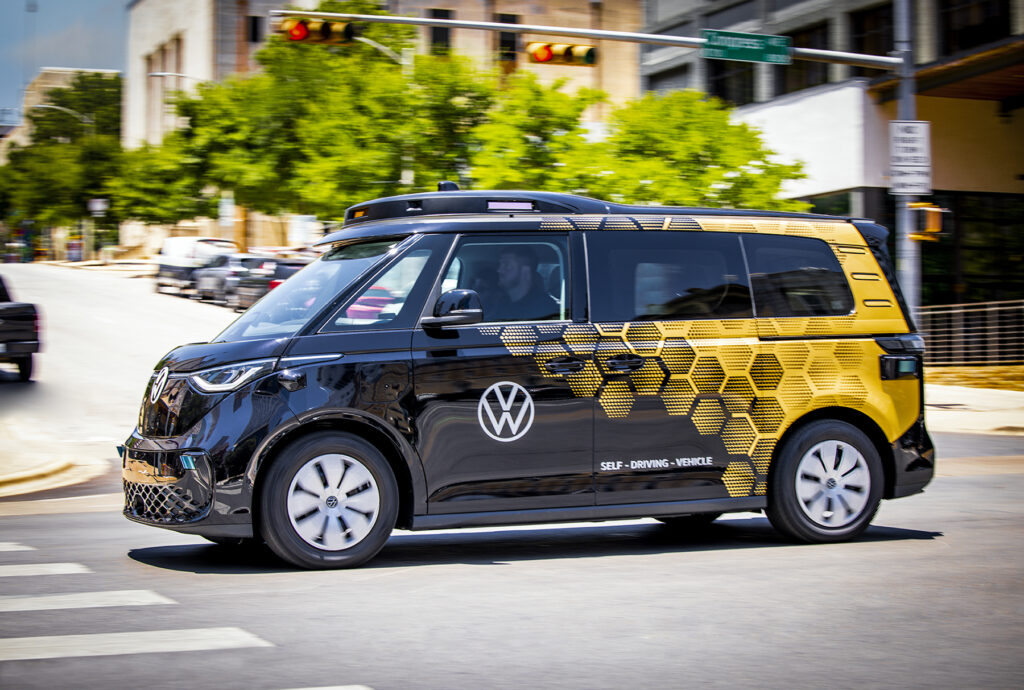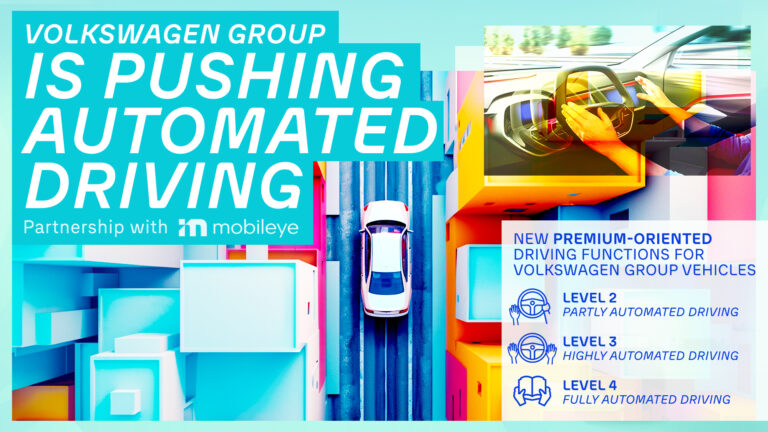The Volkswagen Group is intensifying its partnership with Mobileye to help it bring new automated driving functions to series production. Mobileye will provide technologies for partially and highly automated driving based on its Mobileye SuperVision and Mobileye Chauffeur platforms.
In future, the Volkswagen Group’s Audi, Bentley, Lamborghini and Porsche brands will use these technologies to rapidly introduce new premium-oriented driving functions to their model portfolios across powertrain types. These include advanced assistance systems for highway and urban driving, such as automated overtaking on multilane highways in permitted areas and conditions, as well as automatic stopping at red lights and stop signs, and support in intersections and traffic circles.
In addition, Mobileye is set to supply further technology components for automated driving to Volkswagen Commercial Vehicles. In the long term, the Volkswagen Group aims to rely on its own complete in-house system: however, the company says partnerships with Bosch and Qualcomm, as well as with Horizon Robotics in China, will continue, with all driver assistance systems based on the software architectures developed by Volkswagen’s Cariad company.
“Our goal is to offer our customers throughout the world outstanding products with cutting-edge technology,” said Oliver Blume, CEO of the Volkswagen Group and Porsche. “New automated driving functions will significantly boost convenience and safety. These functions, which will be tailored to our brands and products, will make every trip a personal, individual experience. In Mobileye, we have an additional first-class partner to shape this automotive future together.”
Level 2 and Level 3 functionality
The Volkswagen Group and Mobileye have been collaborating on advanced driver assistance systems for some time. In the future, Mobileye is set to also provide technologies for driving functions with enhanced Level 2 capabilities (‘partially automated driving’) within the Volkswagen Group. When such functions will be available, and subject to its operational design domain, drivers will be allowed to take their hands off the steering wheel but must remain attentive to the traffic and ready to intervene at any time. In addition, Volkswagen is working with Mobileye on Level 3 functions (‘highly automated driving’). At this level, the vehicle will be able to temporarily take over driving tasks in specified areas; drivers are not required to monitor the system continuously.
Volkswagen and Mobileye are jointly developing these technologies into cross-brand systems.
In addition, Mobileye will also offer certain production-ready functions for the new E3 1.2 premium-oriented software architecture. This new architecture is managed by Cariad and will be gradually implemented within the group by Audi, Bentley, Lamborghini, and Porsche. As part of their product strategy, the brands decide on the specific deployment of the systems and tailor them to a brand-specific driving experience.
Level 4 self-driving VW ID. Buzz
Furthermore, the Volkswagen Commercial Vehicles brand is set to be supplied by Mobileye with software and hardware to achieve Level 4 (‘fully automated driving’). Volkswagen ADMT, a Volkswagen Group subsidiary, will implement these components in fully electric development platforms based on the Volkswagen ID. Buzz. The goal of Volkswagen ADMT is to bring self-driving ID. Buzz vehicles to series production for mobility and transportation services.
Mobileye will develop and supply software, hardware components and digital maps for the self-driving ID. Buzz AD. The main part of the agreement covers delivery and use of a self-driving system (SDS) for a special version of the ID. Buzz, which has been under development for autonomous driving since 2021. It corresponds to the Level 4 definition of the Society of Automotive Engineers (SAE), in which the autonomous vehicle operates self-driving in a defined area such as a city. The SDS is comprised of various software and hardware components, including two independent high-performance computers as well as 13 cameras, nine lidar and five radar units, each system is capable of producing 360 degree surroundings. A constant online connection provides the autonomous vehicles with swarm data from other road users about the traffic situation while updating the three-dimensional maps for safe, reliable, and efficient vehicle control.
“Bringing autonomous shuttles on the road in large quantities requires cooperation from strong partners,” said Christian Senger, member of the Board of Management at Volkswagen Commercial Vehicles, responsible for Autonomous Driving, Mobility and Transport (ADMT): “We are developing the first fully autonomous large-scale production vehicle, using Mobileye’s digital driver.”
“We are proud to work closely with Volkswagen Group to make the future of driving safer, more automated and more rewarding,“ added Prof. Amnon Shashua, president and CEO of Mobileye. “Through these programs, we see Volkswagen Group leading the industry in putting AI-powered advanced driver assistance technology in the hands of consumers globally and developing new services with autonomous vehicles.”

VW’s new E3 1.2 and E3 software architecture
Volkswagen is further clarifying the division of development tasks for driver assistance systems between in-house innovation and collaboration for its new E3 1.2 and E3 2.0 software architectures. This will streamline processes and reduce complexity. With strategic partners such as Mobileye, Volkswagen Group is accelerating the rapid delivery of the premium-oriented E3 1.2 architecture, while, in the long term, the group will rely on its own complete in-house (‘stack’) for automated driving across all brands.
For the future E3 2.0 architecture, the Volkswagen Group plans to forge ahead and consolidate its resources and development responsibilities within Cariad, its software company. Together with Bosch, Cariad aims to develop the group’s proprietary complete system. This system will be integrated into the future all-electric, fully digital, and highly scalable mechatronics group platform, the Scalable Systems Platform (SSP).
“We are sharpening our development strategy for driver assistance systems at the same time as heightening our customer focus. We are concentrating on fast, reliable delivery,” concluded Michael Steiner, head of research and development of the Volkswagen Group and member of the Executive Board, Research and Development, at Porsche.


